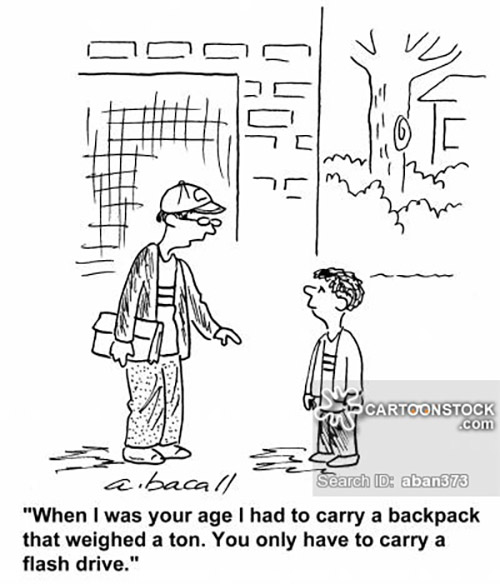
A 1999 survey conducted by the American Academy of Orthopaedic Surgeons found that 58 percent of the orthopedists who responded reported seeing young patients complaining of back and shoulder pain caused by heavy backpacks. The doctors surveyed indicated that heavy backpacks can lead to medical problems in school-age children if they don’t reduce the weight they carry around.
In 2001, a study presented at the American Physical Therapy Association’s national conference in San Antonio showed that school-age children are carrying more weight in their backpacks than their developing bodies can handle. Researchers from Simmons College in Boston found that more than half the youngsters regularly carried backpack loads that were heavier than 15 percent of their body weight. That is the limit recommended by the American Academy of Orthopedic Surgeons. The average weight of a backpack in the Simmons study was 20 pounds. Results of the study were published in the 2001 winter edition of “Pediatric Physical Therapy.”
Multiple factors may cause back injuries, said Shelley Goodgold, an associate professor of physical therapy at Simmons College and the study’s lead researcher. “But we know that the minute you put on a backpack that is over that 15 percent limit,’’ she added, “[students’] heads go forward, and it creates stress and increased forces on the neck and back.” Further complicating that problem is the fact that many schoolchildren can’t tell when the loads they are lugging are too heavy, and the problem is likely to continue beyond eighth grade.
In 2015, in the “The Jewish Link,” this writer highlighted the stresses and strains on young children due to heavy backpacks. A question raised then is still valid today—how many parents weigh their children’s backpacks?
This year, 2018, a new study in the journal “Surgery Technology International” concludes that students bending under the weight of a backpack could experience more than 11 times that weight in stress on their backs. Researchers subjected a model spine to different stresses from weighted backpacks from one to 100 pounds. They measured compression when the spine was straight and again in the typical angle of an adolescent slouch, i.e., tilted forward 20 degrees. For every pound of weight added to the backpack, the researchers found 7.2 times that weight in compression on a straight spine, and 11.6 times the stress on a spine hunched over.
While it is true that many schools are moving to more digital and shared textbooks, the American Occupational Therapy Association estimates that more than 80 million schoolchildren wear backpacks to school. Medical guidelines today have changed in the past decade due to the growing cases of spinal stress caused by heavy backpacks. To avoid this stress, it is now recommended that backpacks be limited to no more than 10 percent of a child’s weight. That means that an average fifth grader should carry no more than six pounds in his/her backpack. However, each book can weigh more than two pounds. In middle and high schools, where students regularly haul packs from class to class all day, individual textbooks can top five to six pounds. Add in books for a few more subjects, random handfuls of homework and returned tests, and all the other stuff that tends to accumulate in kids’ backpacks, and it’s easy to go over the recommended weight.
There are some suggestions to help prevent student back and spine injuries. Textbooks could be printed in paperback, instead of the much heavier hardcover versions, and on lighter paper stock. Schools might also consider providing two sets of books, one for students to keep at home and one for them to use at school. Administrators should encourage students to use lockers instead of shlepping their books around the school building all day.
Only a few states actually limit the weight of textbook materials. California, for example, requires publishers to provide a lighter alternative like a digital text if a paper book weighs more than three pounds in kindergarten through fourth grade, four pounds in grades five to eight, or five pounds in grades nine to 12.
Since students in our day schools have double the number of textbooks, this issue becomes even more significant. Parents and schools leaders should work together creatively to keep our children healthy. There are many texts readily available online, especially in limudei kodesh, and many publishers of general studies texts should be encouraged to do the same. Since we are gradually making the change away from the written text anyway in so many areas, this trend should continue. Perhaps we can lobby our legislators in Trenton to follow the lead of California. See the complete report: “Textbook Weight in California: Analysis and Recommendations.” Available at https://www.cde.ca.gov/ci/cr/cf/txtbkwght.asp. At the very least we can start a conversation with our schools to deal with this important issue.
By Rabbi Dr. Wallace Greene










